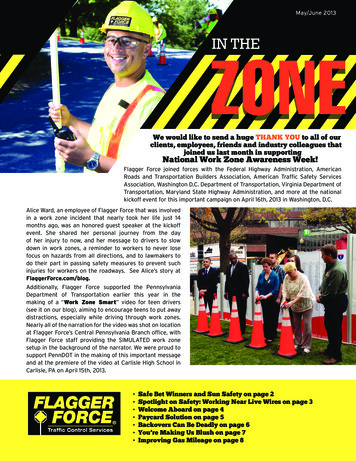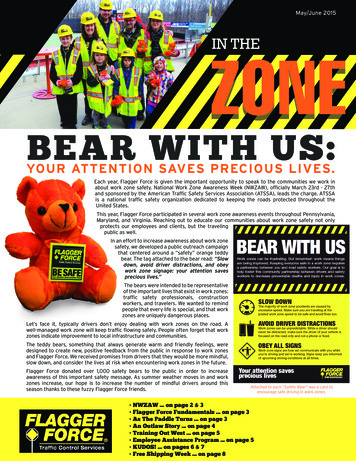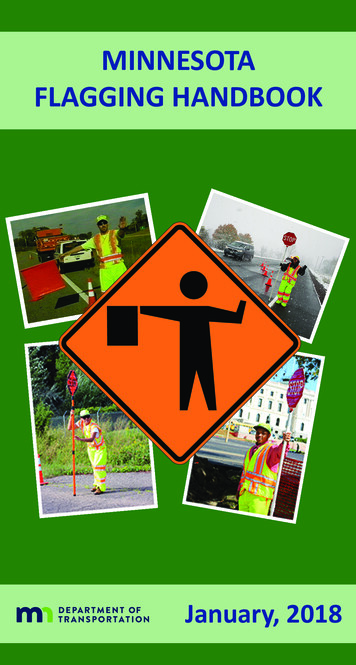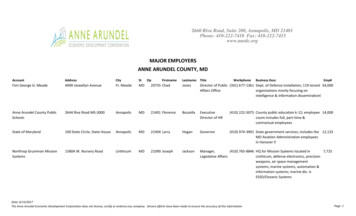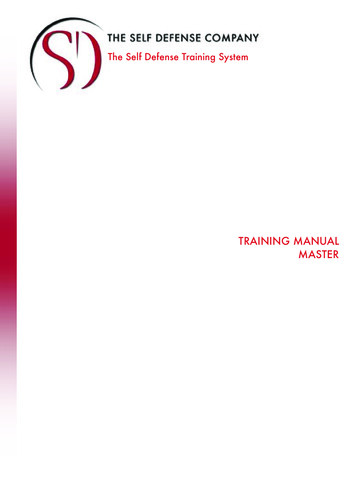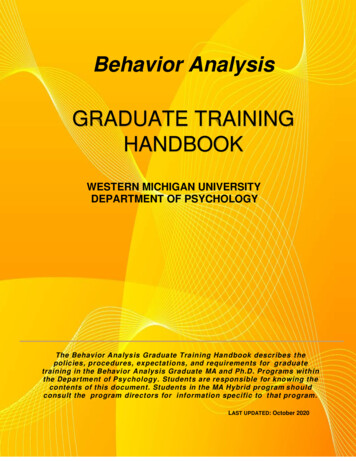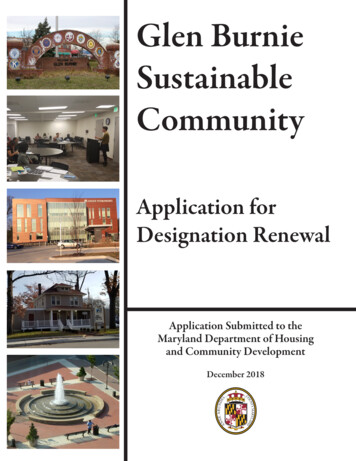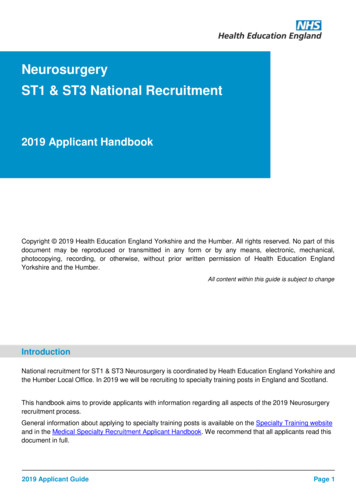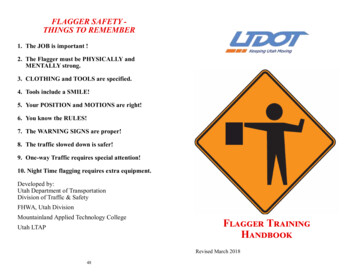
Transcription
FLAGGER SAFETY THINGS TO REMEMBER1. The JOB is important !2. The Flagger must be PHYSICALLY andMENTALLY strong.3. CLOTHING and TOOLS are specified.4. Tools include a SMILE!5. Your POSITION and MOTIONS are right!6. You know the RULES!7. The WARNING SIGNS are proper!8. The traffic slowed down is safer!9. One-way Traffic requires special attention!10. Night Time flagging requires extra equipment.Developed by:Utah Department of TransportationDivision of Traffic & SafetyFHWA, Utah DivisionMountainland Applied Technology CollegeUtah LTAPFlagger TrainingHandbookRevised March 201848
TABLE OF CONTENTSIntroduction .3Uniformity .4Authority .5Certification .6Flagger Qualifications .7Proper Conduct 8Protection & Comfort 9-10Safety Clothing . .10-12Tools & Equipment Requirements .13-15Flagger Station 16Signal to Stop Traffic .17-19Signal to Release Traffic .20Signal to Slow Traffic .21Using a Flag 22Pedestrians, Bicyclists, those with Disabilities .23Emergency Vehicles 24Special Circumstances 24Liability .25Appendix A (Utah MUTCD, Chapter 6E) . .26-32Appendix B (Utah MUTCD, Partial information fromChapters 6F & 6H) .33-47- Traffic Control Zone Elements .34-35- Advanced Warning Signs .36-38- Channelizing Devices 39- Signalized Intersection Flagging 40- Assorted Typical Applications (TA) .41-47247
INTRODUCTIONLane closure at intersectionTA-27 pg. 687Being a Flagger is an important job. A flagger has the charge toprotect the lives of workers, motorists, pedestrians, and bicyclistson the roadway.Flaggers may controltraffic through asignalized intersectiononly when the signalhas been turned to theall RED flash mode orare inoperable.A uniformed lawenforcement officer isrequired when thesignal is operational.Flaggers should never forget that LIVES,equipment, and material are in your hands.Road construction, road maintenance, municipal services, andutility operations may not be safe without a flagger.A vital element of a traffic control plan is the flagger. Flaggersare used when other traffic control devices are unable to safelydirect traffic through a work zone.Flaggers should be active, able bodied men and women who possess a good temperament, eyesight, and hearing. Flaggers shouldbe intelligent and have the capability of securing the travelingpublic’s cooperation through effective communication.A flagger should never take their responsibilities lightly. Not onlymust the flagger provide for their own personal safety, but alsothe safety of fellow workers and the public. Flaggers must alsohelp protect thousands of dollars in equipment and materials.A flagger may be the first contact by the public on a project. Theimpression the flagger creates will reflect on the organizationdoing the work. Therefore the flagger is also a public relationsperson.The training you are about to receive will help prepare and guideyou in these responsibilities.463
Flagger with a pilot carfrom UDOT Standard Drawings# 1. UNIFORMITYUniformity is a very important part of highway safety and operations. Motorists should not be subjected to undue changes. Whenchanges are necessary, the motorist should be able to react in asafe and deliberate manner.Two-way communications recommendedwith pilot car operations. If not available,baton method is acceptable.All flaggers, wherever they are working, should be using thesame commands and hand signals so that motorists are not confused as they enter various work zones.Flaggers should be dressed in similar attire. This helps the traveling public recognize the flagger as a control element.Flaggers should be positioned in similar locations from site tosite. This helps the motorist judge where they may most likelyencounter a flagger.Use this sign on the backof the pilot vehicle.Same sign sequence, spacing, tapers andbuffers for opposite direction requiredThe flagger certification program has been developedby using standards set forth in theUtah Manual on Uniform Traffic Control Devices (MUTCD)and by practices that have beendeveloped through experience.A major goal of the certification program is to ensure thatall flaggers conduct themselvesin a professional, uniformmanner and that all whoencounter a work zone, witha flagger present, willreceive safe passage throughthe work zone.445
Highway-Rail Crossing w/ Flagger(TA 46) MUTCD pg 6H-97UDOT or other governmententities may have adopted ahigher standard. Consult theagency when required.44NOTE: If creating a waitingline across active rail trackscannot be avoided, a flaggeror law enforcement officer isRequired. This applies even ifautomatic warning devices arein place.# 2. AUTHORITYUtah State Law 41-6a-209(1)(c) {Revised 2005} Flaggers have the same authority as a law enforcementofficer to control traffic. The flagger must be in an active work zone and alltraffic control must be in place to exercise this authority.The only exception would be if you have an emergencysituation.5
# 3. CERTIFICATIONHaul Road Crossing with Flaggers(TA 14) MUTCD pg 661UDOT or other governmententities may have adopted ahigher standard. Consult theagency when required.The Utah Department of Transportation requires all flaggers to betrained and to carry a Flagger Training Certificate. Inaddition to receiving the training an applicant must also meet agerequirements established by the Utah State Labor Commission.The Flagger Certification is good for a three (3) year period. Theflagger must attend a re-certification seminar and bere-certified every three (3) years.Same sign sequence required for opposite direction.The Utah Department of Transportation is requested on occasionto accept additional certification programs. The Department willreview each program, and each acceptable program will be listedin the Utah Department of Transportation Standard SpecificationSection 01554 Traffic Control.Some utilities and other government entities conduct their owntraining, the instructors for this training are certified by UDOT.This certification is only good on roadways under UDOT jurisdiction, while working for the issuing entity. A flagger must receive a new certification from one of the accepted certificationprograms before working for another employer.All individuals who work at a flagging station must becertified. The certification card must be on your person whileyou are working on the roadway.NEVER LEAVE YOUR FLAGGING STATIONUNATTENDED, OR TO A NON-CERTIFIED FLAGGER.**Flaggers, who are found in noncompliancewith UDOT Standards, Policies and MUTCDGuidelines for flagging, may result in revocation of Flagger Certification.**643
Temporary Road Closure (TA 13)From MUTCD pg 660UDOT or other governmententities may have adopted ahigher standard. Consult theagency when required.Same sign sequence required for opposite direction.# 4. FLAGGER QUALIFICATIONSTHE FLAGGER:1. Must be in Good Physical Condition good hearinggood visionmobile enough to escape danger (errant vehicle)be able to control signaling device (paddle) in adverseconditionsable to work on site 8 hours or more2. Must be Intelligent receive and perform specific instructionhave common sense and good judgmentmake wise and informed choicesadapt to changing situationsrecognize dangerous situation and react3. Must be Mentally Alert pay constant attention to trafficreact to emergency situationsbe able to maintain composure4. Must be able to Communicate be courteous and patientgive clear directions and instructionsbe able to take a firm command of situations without being rude or a “bully”be able to give motorist further assistance if they are notable to understand your direction5. Must maintain a Neat Appearance(optional)42 have clean clothing and equipmentremember you are the first line of public relationswill help command the respect required to perform yourduties7
# 5. PROPER CONDUCTLane Closure onTwo Lane RoadsWith Flaggers(TA 10)MUTCD pg 653THE FLAGGER:UDOT or othergovernments entitiesmay have adopted ahigher standard.Consult the agencywhen required.1. Should provide information to motorist, if possible Be courteousBe ProfessionalBe Brief“There is a loader in the left lane around the curve.”2. Should not visit with the motorist Do not lean on the motorists vehicleDo not allow conversation with the motorist distract youfrom your flagging responsibilities3. Must not argue with the motorist Be kindBe understanding4. Document disobedient motorist Stay out of harms wayDo not leave your flagging stationNotify co-workers of the situationRecord vehicle description and plate numberReport the circumstances to your supervisor5. Needs to provide accurate information Ensure signs used to identify a flagger condition are removed or covered when you are not actually flagging6. Must be alert to emergency situations Follow your emergency planProvide a means for the emergency vehicles to get throughthe construction area in a timely manner841
FLAGGING AT SIGNALIZED INTERSECTION(UDOT Standard)Flaggers may flag at a signalized intersection onlywhen the signal has been turned to the all RED flashmode or are inoperable. If the signal is fullyoperational, a uniformed law enforcement officer isrequired for controlling traffic through the intersection.Flaggers are required for each leg of the intersectionand may only control the traffic for two through lanes,and one left or right turn lane (if present).# 6. PROTECTION & COMFORTAs a flagger you will be working in different traffic conditions andvariable weather conditions. To meet these demands you must beprepared to protect yourself to changing conditions.1. Sleep Be well rested prior to starting your shift. By being wellrested you will be able to withstand the rigors of a longshift and perform your duties in a professionalmanner.2. Comfortable foot wear Due to the potential hazard of vehicles driving over yourfeet, you are required to wear safety-toe footwear. You willbe standing for long periods of time, make sure the footwear fits and will protect your feet from the elements.3. Clothing You have basic requirements for clothing but with the variables of the weather you may need to adjust how you meetthese requirements. By using layered clothing, you canbetter adjust comfort needs. Have foul weather protectiongear available.You have specific requirements for safety outer clothingyou must wear, this is addressed in Section # 7.4. Sun Protection 40Both winter & summer, you will need:Sunglasses that are safety glasses and have the ability toblock UVA & UVB rays.Sunscreen and lip balm with a sun protection factor (SPF)and a UVA & UVB block.9
5. Nourishment Always have water or other non-carbonated drinks available.NO alcoholic beverages.Have something available to eat. This will help keep yourstrength from dissipating between breaks.Channelizing devices on UDOT controlled projects6. Breaks Prior to starting your shift, arrange with your supervisorwhen breaks will occur.NEVER LEAVE YOUR FLAGGING STATIONUNATTENDED OR TO A NON-CERTIFIED FLAGGER# 7. SAFETY CLOTHINGMust be used in tapers when postedspeed is 50 MPH or greater. May beused on any highway.Vertical panels require a retroreflective area of 270 sq. inches whenused on highways with postedspeeds of 50 MPH or greater.UDOT requires the retroreflectivearea be 12 inches above the roadway. May be used in tapers andtangents with speed 45 MPH or less.1. Flaggers must be fully clothed in appropriatework clothing. Full length pants No shorts or cutoff pants.Short/long sleeved shirt Short sleeved shirts must cover the shoulder andextend down the arm and cover the entire upperportion of the body.No tank tops Safety-toe Footwear Safety Glasses Required when on UDOT controlled projects.Sun glasses are advised during sunlight exposure.Must be worn during night operation.Glasses that improve vision at night or in overcast conditions (i.e. clear or amber lenses) are advised.Safety glasses must have side protection.10See TC Standard Drawingsfor use of cones and tubularmarkers.Cones and tubular markerscannot be used on freeways,divided highways, or roadswith a speed limit of 55 mphor greater.Tubular markers may not beused as a lane closure taperdevice and are for day-timeuse only.39
High Visibility Safety Apparel (Retroreflectivesafety outerwear) NOTE: If two flaggers are being used, an advance flagger symbol sign is required in advance of each flagger. If used inside channelizing devices it must bevisible above the channelizing devices. High Visibility Safety Apparel is defined as fluorescentorange-red or a combination orange-red/yellow-green,shirt, vest, coat, coverall, etc., outerwear that meets thePerformance Class 3 requirements of the ANSI/ISEA 107(current year) publication.Safety outerwear retroreflective material will be orange,yellow, white, silver, yellow-green or a florescent versionof these colors.Retroreflective safety outerwear must be worn during daytime and nighttime operations.The outerwear will have a minimum of 50% backgroundcolor of fluorescent orange-red.Fluorescent orange-red hard hat Hard hats must meet the ANSI/ISEA 107- (current year)standard with a minimum of 10 square inches of retoreflective material and placed so that it is visible to trafficfrom all directions.UN-ACCEPTABLE CLOTHING AND ACCESSORIES Tank tops or halters.Short pants and cutoffs.Soft baseball style hats.Portable radios, or other devices which could distract youPersonal listening devices with headphones or ear piecesCANNOT be worn.(exception: hearing aids or communication devices usedto stay in contact with others on the work crew).NOTE: The listed buffer zone lengths are required on UDOT controlled projects. Consult Standard Drawings, TC Series, for additional information.3811
High Visibility Safety OuterwearTypical sign stands and height requirementsNot Fire RatedType R Roadway UseClass 3 Performance Class(provides greater visibility)Hard HatSafety GlassesSigns on portable stands require 2 orange warning flagswith orange retroreflective sheeting.Safety-toe Footwear1237
arningAdvancedwarningsignsarediamondshaped, shaped,with blackwithsymbolor messageAdvanced warning signs are onstruction signs used on roadways under their jurisdiction toconstructionsignson roadwaysunder “Situation”,their jurisdictiontobe48” x 48”. Signsareusedcategorizedas “ Attention”,and �Attention”,“Situation”,Supplemental signing may be used in conjunction with the advanced warningsignsand may be squareor rectangularin shape.StandardDrawand “Action”.SupplementalsigningmaySeebeUDOTused inconjunctionings,for supplementalsign sizerequirementsand flagordetail.withTCtheSeries,advancedwarning signsandmay be squarerectangu-# 8. TOOLS & EQUIPMENTREQUIREMENTS1. ADVANCE WARNING SIGNS lar in shape. See UDOT Standard Drawings, TC Series, forsupplemental sign size requirements. ATTENTION SIGNING SITUATION SIGNINGFLAGGER SYMBOL SIGN required in advance of allflagging stations. This will be the final sign in the signingsequences of the approaching traffic.Refer to UDOT Standard Drawings TC series for signs inthe sign sequence.Retroreflective sign required when used at night. Material as specified in UDOT Standard Specificationand/or the Utah MUTCD.2. STOP/SLOW PADDLE: Flagger shall be equipped with a Stop/Slow paddle aheight of 7 feet (24” paddle and 60” handle) Stop/Slow Paddle requirements: octagonal shape, with asemi-rigid substrate and a rigid handle. 24 inches x 24 inches with 8 inch letters required. UDOT Standard Drawings TC Series. Retroreflective when used at night. Light (s) permitted on paddle as specified in the UtahMUTCD.Holes shall not be permitted in paddle face.3. FLAGSSUPPLEMENTALSIGNING ACTION SIGNING36Use in emergency situations only. Will be red or florescent orange-red in color. 24 inches x 24 inches on a 36 inch staff. The free edge should be weighted so the flag hangs vertically, shall be retroreflective red or florescentorange-red when used at night .4. NIGHT FLAGGING Flagging station will be illuminated with an external lightsource at night. (UDOT & UTAH MUTCD requirement) Night defined:Begins 30 minutes after sunset(Utah Code 41-6a-1603) Ends 30 minutes before sunrise Street lights and vehicle headlights are not an acceptablesource of illumination. Red Flagging Wand or Flashlight equipped with a red 6inch (minimum) wand is required.13
TOOLSComponents Temporary Traffic Control ZoneSTOP/SLOW PaddleFlagger Symbol SignFlagging Wand orFlashlight w/wandExternal Light SourceRED or Orange-red Flag1435
TRAFFIC CONTROL ZONEThe Traffic Control Zone consists of specific sign types, channelizing devices, advanced warning displays, and one or moreflaggers. The way these devices are installed and maintained iscrucial to how traffic flows through the work area.5. OTHER EQUIPMENT Pencil & Pad Used to keep records of incidents. If a crash occurs, write down any information thatmay apply to the crash while it is still fresh inyour mind. Record vehicle and driver information. If a problem occurs such as a driver running yourstop command, first protect yourself, warn yourfellow worker, return back to your workingposition, then try to record license plate information, brief description of vehicle , and description of the driver. Whistle or air horn Used to warn those in the work area of an emergencysituation, or dangers. Communication devices Used to communicate with other flaggers, supervisors,or other workers.This training does not certify you as a Traffic ControlMaintainer but it will give you an understanding of thetraffic control zone.The Traffic Control Zone consists of the following elements:1. Advance Warning Area The area in the section of highway where road users areinformed about the upcoming work zone or incident area. Warning signs2. Transition Area The transition area is the section of highway where roadusers are redirected out of their normal path. Delineated by channelizing devices3. Activity Area The activity area is the section of highway where thework activity takes place. buffer space (both lateral & longitudinal areas) work space traffic space Delineated by channelizing devices and may havesigns4. Termination Area The termination area is used to return road users to thenormal path. May be delineated by channelizing devices and mayhave signs3415
# 9. FLAGGER STATION1. Flaggers should be positioned on the shoulder ofthe roadway in a conspicuous position facingapproaching traffic. Flagger should be visible to approaching traffic a distanceequal to sign spacing requirements. Refer to Sign SpacingChart (page 38).Location should be such that an errant vehicle can stopbefore entering the work space.2. Flagger station should be free of obstructions. Personal vehicles and other work vehicles cannot beparked within 100 feet from the flagging station.Flagging station should be clear of clutter (i.e.; coolers,work bags, or lunch pails).Flaggers should be able to move around other traffic control devices freely.3. Flaggers should plan an escape route. If an errant motorist or work vehicle does not see you ordoes not obey your command, have an area to which youcan move without being injured.APPENDIX BManual On Uniform Traffic Control DevicesPart 6Chapter 6F Traffic Control Devices (partial)Chapter 6H Typical Applications (partial)These are minimum standards set by theFederal Highway Administration.The Utah Department of Transportation mayhave higher standards.Check the Standard Specification Section01554 and the Standard DrawingTC Series for specific requirements.Buffer Space100’ min.Do not park your vehicle orallow other work vehicles to bewithin 100 feet from the flagging station. (not to scale)Stand far enough away fromthe work space, using the appropriate buffer space, so thatan errant vehicle can stop.(not to scale)1633
# 10. SIGNAL TO STOP TRAFFIC321.Stand in a safe position on the shoulder of theroadway facing traffic. Look directly at theapproaching driver.2.Communicate intentions with other flaggers andworkers when required.3.Have the paddle in the “STOP” position in yourright hand directed toward the approachingvehicle.17
4. Raise your free arm and hold palm of hand aboveshoulder level toward approaching traffic. Make eye contact with driver prior to changing positions.24 Inches5. After first vehicle has come to a complete stopmove to a conspicuous position near the centerline. Do not stand in front of first stopped vehicle. Use caution at center line position. Be awareof vehicles coming from the opposite direction.1831
STOPPING DISTANCEFlaggers need to pay special attention when theyhave to stop approaching vehicles. Weather and road conditions need to be taken into account when stopping traffic. Allow for driver reaction time, which is the time ittakes a driver to apply the brakes after seeing theSTOP sign.The following chart shows the required stopping distance for theaverage vehicle under described conditions.MPH DryGravelPavement SurfaceWetPavementPackedSnowIce 6’561607’808’1830’Large trucks can require 400 ft. or more to stop.HINT: Prior to starting your shift, evaluate the speed of theapproaching traffic. Determine a point in front of you that ifan approaching vehicle passes you will not be able to stopthe vehicle safely.Mark the point at which you should begin stopping trafficwith a cone, or associate that point with a tree, rock, or someother physical marker.3019
# 11. SIGNAL TO RELEASE TRAFFIC1.Communicate intentions with other flaggersand workers when required.2.Move from the center of the roadway, with thepaddle in the “STOP” position, to a safeposition on the shoulder.3.Turn your paddle to the “SLOW” position.With your free arm away from your body, motion the traffic to proceed.2029
# 12. SIGNAL TO SLOW TRAFFIC1. Communicate intentions with other flaggers andworkers when required.2. Stand in a safe position on the shoulder of theroadway facing traffic and look directly at the approaching driver to make eye contact.3. Have the paddle in the “SLOW” position in yourright hand.4. With your free arm, extended away from yourbody, and the palm of your hand down, use an upand down motion.2821
# 13. USING A FLAGEMERGENCY SITUATIONS ONLYAn emergency is an unforeseen situation which requires immediate action.Because you are in an emergency situation communication with those assisting will be vital to protect you,them, and motorists.The procedures and positioning for using a flag are similar as a paddle, except for the To Alert & Slow procedure. In this procedure, the flag is slowly waved in asweeping motion and the free hand is kept down.FLAG REQUIREMENTSRED or FLOURESCENTORANGE-RED FLAGONLYSTOP POSITIONTO PROCEEDTO ALERT & SLOW2227
APPENDIX AUtah MUTCD(Manual On Uniform Traffic Control Devices)# 14. PEDESTRIANS, INCLUDINGTHOSE WITH DISABILITIES, ANDBICYCLISTS Special considerations should be given topedestrians, including those with disabilities,and bicyclists who enter the work zone and require your assistance. Check work zone activities with other flaggersand workers prior to allowing pedestrians andbicyclists to pass through the work zone. Theymust be able to pass through safely. Have approaching traffic under your controlprior to directing pedestrians or bicyclistthrough the work zone. Allow traffic to clear prior to directingpedestrians and bicyclists through the workzone. If impractical,stop traffic and directpedestrians or bicycliststhrough the work zoneseparately.Part 6 Temporary Traffic ControlChapter 6E Flagger ControlThese are minimum standards set by theFederal Highway Administration.The Utah Department of Transportation mayhave higher standards.Check the Standard Specification Section01554 and the Standard DrawingTC Series for specific requirements.Partial list of UDOT Standards exceeding theUtah MUTCD Retroreflective outerwear must have aminimum of 50% fluorescent orange-redbackground color.Fluorescent orange-red retroreflectivehard hatSafety-toe footwearPaddle size, 24” x 24” with 8” lettersDo not use Automated Flagger AssistanceDevices (AFADs) on State Routes.2623
# 15. EMERGENCY VEHICLES# 17. LIABILITYHave a plan developed to move emergency vehiclesthrough the work zone.1. A FLAGGER can be held liable for damages or injuriesincurred if a crash occurs. With the Work Zone Supervisor, develop a plan to moveemergency vehicles around or through the work zoneEmergency vehicles must stop, if commanded by you.Allow them to pass as soon as possible. 2.The EMPLOYER of the flagger can be held liable fordamages or injuries if a crash occurs. The employer isresponsible to: # 16. SPECIAL CIRCUMSTANCES Ask your supervisor each day if there are plansfor an oversized load to come through thework zone. Develop a plan to move unexpected oversizedloads through the work zone. Be aware of planned deliveries of equipment ormaterials for the project.243.Make sure all traffic control signing and devices are inplace.Give good direction using the proper signaling techniques.Be aware of the situation.Stay alert.Allow traffic to pass only when a safe path is available.Provide the proper traffic control.Instruct flagger of any special conditions or requirements.Provide flagger with rest periods.The ORGANIZATION having work done can be heldliable for damages or injuries if a crash occurs. Ensure the contractor is complying with your organizational standards and requirements.25
training, the instructors for this training are certified by UDOT. This certification is only good on roadways under UDOT jurisdic-tion, while working for the issuing entity. A flagger must re-ceive a new certification

